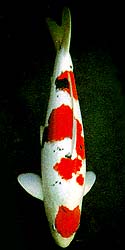"Changes Can Come Quickly" In recent years, there has been a tremendous increase in the popularity of the Goshiki, especially here in the United States. The Goshiki is a particularly difficult koi to finish and maintain in our waters, not only because of the overall hardness and alkalinity, but because the very nature of a Goshiki is to become darker and darker as it grows and matures. The Goshiki featured here was purchased as a yearling from Hosokai Yorijyo in Ojiya by Mr. Kenji Kimura of Chigasaki. Hosokai is known not only for his Goshiki, but also for his world-class Asagi.
At ten months old and about 7 inches long, we can see that a generally undefined sumi (black) is overlaid with a translucent but luminous hiban (red pattern). The key to selecting this koi at this stage of its development is in the quality of the red in what might otherwise seem a dubious choice for a tategoi. A mere six months later, we see that the Goshiki has grown to an impressive 16 inches. The sumi has clearly established itself in the classic Asagi fashion while at the same time receding from the hiban leaving the beni (red) free from redundant black. The beni has kept its earlier promise and is well on its way to becoming the thick, deep beni that Hosokai Goshiki are known for. The final photo, taken only ten months after the first one, shows Mr. Kimura's Goshiki at 20 months old and just shy of 20 inches. The sumi has developed to the point that it is threatening to invade the hiban. The development documented in these photos took place in the short period of 10 months, but the most difficult task of maintaining this Goshiki in its "finished" state lies ahead. Early this spring at a koi show in San Diego, when a similar Goshiki took Best In Size, the judge Mr. Hanaoka commented that someone had taken very good care of this Goshiki as "A finish like this is difficult for the best of koi keepers to maintain."
Though the sanke featured here is also one of Mr. Kimura's koi, he was unable to provide any information regarding size, bloodline etc. The time lapse between the first and second photo was two years and three months. Notice how the underlying sumi in the head and at the shoulder have completely disappeared leaving a crisp white field for the kohaku pattern to float on. One can expect the tsubo sumi at the base of the dorsal fin, side and shoulder to continue to emerge providing the owner with the continuing joy of keeping a true tategoi.
BACK TO TOP |
||||||||||||||||||
|
|
||||||||||||||||||





